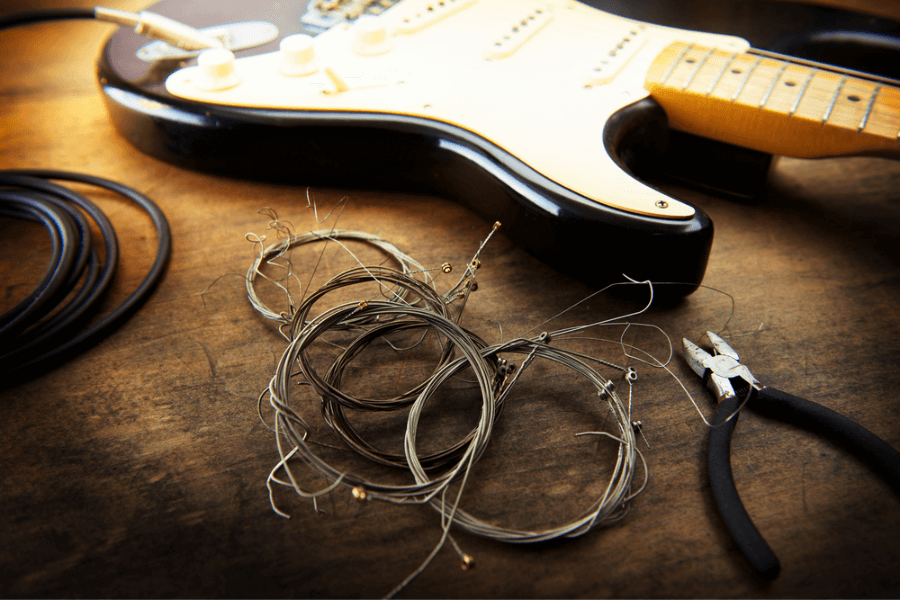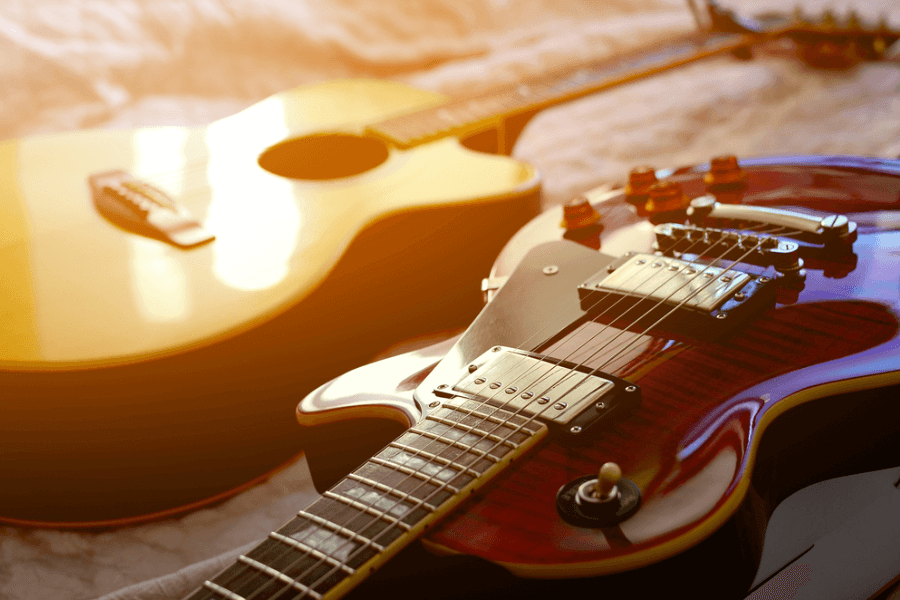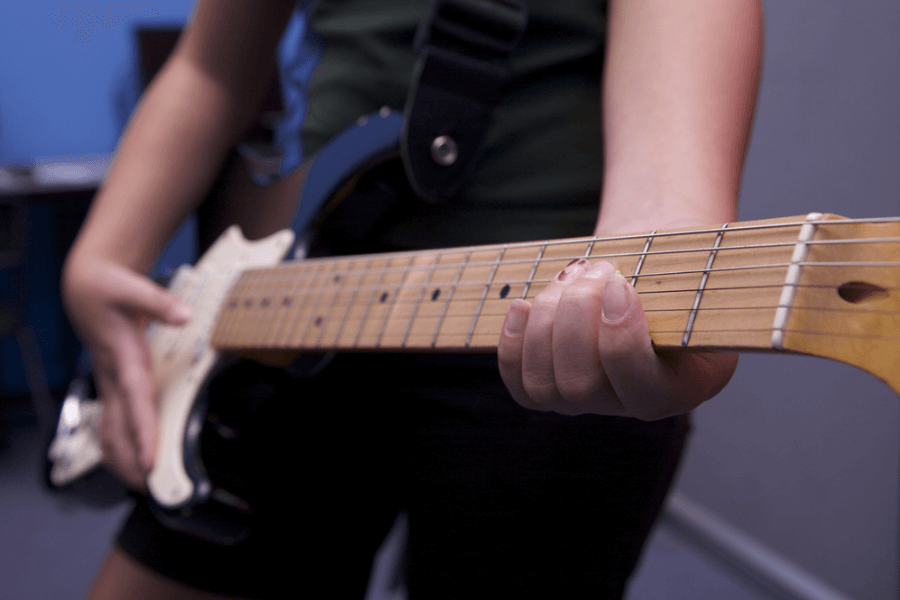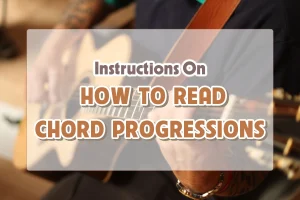Playing the guitar can be an exciting journey filled with creativity and self-expression. However, like any skill, it’s easy to make mistakes along the way and our mistakes are often easy to spot and predict. These problems leave many to wonder, “Why does my electric guitar sound bad?“.
In this article, Eguitarmania will be here to break down all the reasons why your guitar is sounding bad, as well as offer up some surefire ways to fix these problems. It’s true that two guitars made by the same brand in the same workshop can sound very different from one another. Keep on reading to learn these must-have tips and tricks!
Importance of String Choice
While there are many strings that can handle playing a wide variety of music decently well, there are others that are specifically designed to enhance certain types of music. Check out this post that has guides to help you get the right strings for the music you want to play.

New strings, new start
Guitarists may hear a considerable difference when they change strings. Famous guitarists like Eric Clapton and Jimmy Page use certain strings to create their instruments’ distinctive tones. New nickel-plated steel or pure nickel strings improve guitar harmonics. New nickel-plated steel strings are appreciated for their bright, energetic tone, which works well in rock and blues.
Science says the new strings sound better because they move more freely. Keeping dirt and rust off the strings lets them vibrate properly and provide a clean sound. Guitar technicians and musicians recommend replacing strings before recording for optimal sound.
Old Guitar String Dampening Effect
Due to wear and player sweat and dirt, strings lose smooth and durability. This is a major issue that affects sound quality. Famous guitar expert and author Dan Erlewine writes on how aged strings may affect tuning and response, flattening sound and reducing dynamic range.
Many specialists say worn strings sound less “sparkly,” supporting this. Poor string quality could negatively impact jazz and classical rock performances, which need clarity and phrasing.
String Slippage: Unstable
The biggest issue with slipping strings is tuning instability. Strings tied around tuning pegs typically cause this difficulty. When pressured, a poorly wound string may slide and affect guitar tune. Famous guitarists like Steve Vai say they wound and stretch strings to prevent slippage. They emphasise string security to maintain tune.
To remedy this issue, several companies have created strings with stronger cores or locking methods. A strong player may utilise the Ernie Ball Paradigm strings, which feature an ultra-high-strength steel core to prevent breakage and slippage.
Why Does My Electric Guitar Sound Bad?
The tone knob on an electric guitar might seem like a minor feature, yet it holds substantial sway over your sound. Focusing on key elements such as the tone knob and the amplifier, providing actionable insights to troubleshoot and refine your tone.

Tone Knob
Basically, this setting changes the frequency range to change how bright your guitar is. It cuts out high frequencies, which make the music warmer and mellower. Turning the knob up, on the other hand, lets more treble through, which makes the sound louder and brighter.
Start with the knob at 10 (fully open) and gradually decrease to hear the subtle shifts in sound. A higher setting might be better for jazz and blues, which need clear and concise leads. On the other side, reducing the treble may help provide a more rounded rhythm tone in rock and pop.
An amplifier and its settings
- Gain/Drive: Controls distortion or boost, crucial for blues and metal. For jazz or country, lowering the volume improves clarity. Hitting gain creates rock and metal listeners’ favourite harsh distortion.
- EQ (Bass, Mid, Treble): settings balance sound. Current rock sounds snappy and bright with the “smiley face” EQ, which amplifies lows and highs. However, boosting the mids and decreasing the highs and lows might provide a throwback rock and blues sound.
- Echo: This adds depth and texture to sound. Echo may muffle your tone, yet the appropriate amount can improve your playing and sound.
- Master volume: prevents the power amp from overpowering your tone. Higher levels bring forth tube amps’ full sonic potential. Volume alters amp depth and dynamics.
Playing Ability and Technique
Remember, the path to better sound is a journey of continuous learning and practice.
Change Your Practice Routine
Playing and sounding better on the electric guitar requires a well-organized practice routine. Random or inconsistent practice not only slows your growth as a guitarist but also leads to the development of bad habits.
Implementing Effective Practice Strategies
- Slow Practice: Slow down difficult passages to a tempo where you can play them accurately. This technique allows you to internalize the proper finger movements and articulations, improving both your precision and sound quality.
- Consistent Feedback: Recording my practice sessions and listening back critically has been incredibly helpful.
- Focused Practice Sessions: Split up your practice time into smaller chunks and focus on a different skill or piece at a time. This method promises that players will get better and keeps them from missing out on important parts of the game.
Lack of Ear Training
Ear training is an often overlooked aspect of guitar playing that profoundly affects how you perceive and produce sound.
Learn to identify different chord types by ear. Having a well-trained ear allows me to distinguish subtle tonal differences, enabling me to adjust my playing technique and gear settings for optimal sound.
Fretting Hand Technique
Poor fretting technique can lead to buzzing notes, intonation problems, and a muffled or unclear sound.
Refining Fretting Hand Technique
Finger Independence: Exercises designed to increase finger independence can greatly enhance your fretting technique, allowing for cleaner, more articulate playing.
Finger Positioning: Ensure your fingers are close to the fretwire when pressing down a string. This position requires less force for a clean note and improves intonation.

Strumming Hand Technique
The strumming or picking hand determines the attack, dynamics, and rhythmic precision of your playing.
Developing a Dynamic Strumming Technique
Pick Angle and Grip
Experiment with different pick angles and grips to find the one that offers the best control and tone for your style of playing.
Dynamics Control
To improve your strumming technique and express yourself more fully, try playing at a range of volume levels, from mild to loud. The emotional depth of your playing is enhanced by this variety.
Frequent Mistakes Guitarists Make
Each of these insights comes from overcoming personal hurdles on the guitar. Understanding and addressing these mistakes early on can significantly improve one’s playing skills.
Not using a metronome
I learned the hard way that not using a metronome will cause you to have bad time, which is especially noticeable when playing with other people. I remember trying to play a simple 4/4 rhythm piece and realizing in the middle of the performance that I was out of time. This made it clear that I wasn’t in step with the band. Early metronome practice, even in simple tasks, made it a lot easier for me to stay in sync with other musicians.
Pressing too hard
In the beginning, practicing would often make my fingers hurt a lot, not because I was getting calluses, but because I was pressing the strings harder than they needed to be.
This habit not only made things uncomfortable, but it also made it very hard to switch between sounds quickly. Learning to loosen up my grip was a turning point. It made playing easier and let me practice for longer periods of time without pain.

Avoiding music theory
When I first started, I relied on tabs and copying songs by ear, which worked for a while. But it became very clear to me what my limits were during a jam session where improvisation was important. Learning about music theory gave me more freedom to be creative. It helped me understand chord progressions and scales, which improved my ability to improvise and make music in generally.
Conclusion
Several factors can influence the quality of an electric guitar’s sound, including improper setup, old strings, poor playing technique, and inadequate equipment. Experts often emphasize the value of experimenting with amp settings and effects pedals to find the unique sound that speaks to you. Finding the sweet spot between technical maintenance, ongoing learning, and experimentation is the key to getting the most out of your electric guitar.









